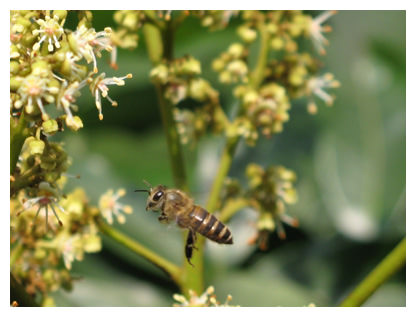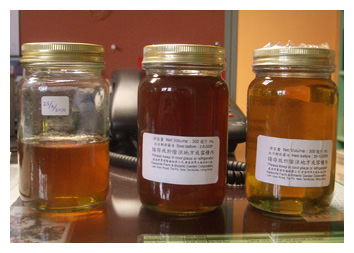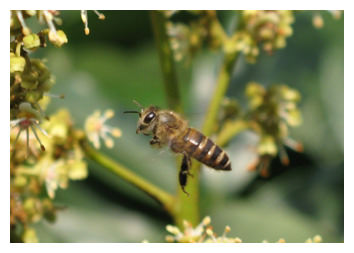KFBG Honey: "Bee" sweet to nature

While feasting their eyes on sylvan upland vistas and seasonal blooms, visitors to KFBG will also see lots of bees around the Farm. Although honey is not a staple product of our Sustainable Living & Agriculture Department, bees still play an important role in our overall operation.
"To 'ecological' farms and fruit orchards, bees do only good and no harm. They are active pollinators," says Sustainable Living & Agriculture Department Senior Officer Yip Tsz Lam, "and only modest resources are needed for keeping bees because there is no water consumption, no fertiliser, and the bees will feed themselves. The only thing you have to do is to provide a home." It sounds very easy, however, the geographical location of KFBG does pose some challenges for keeping bees.
Adverse environmental factors result in unique varieties of honey
Most local bee farms are located in rural areas, and fruit trees like lychee and longan are the primary nectar sources. Lychee and Longan flower between April and May. Given KFBG’s high elevation, it is usually quite foggy at this time of year and it is very difficult for bees to visit flowering plants to gather nectar. "Bees cannot collect nectar when it is too dry or too humid. The ideal Relative Humidity is about 80%. Unfortunately, the humidity is often higher than 90% at the Farm in April." Nevertheless, permaculturists can always find ways to turn problems into solutions. Yip Tsz Lam said with a smile, "And it is for exactly this reason that KFBG honey stands out from other local varieties."
KFBG may not have fruit trees as the major source of nectar but there are plenty of other nectar plants. These are forest trees such as Machilus that flowers profusely in March and the Ivy Tree that flowers in December.
"I'm not sure whether these honey varieties have any dietary or health benefits but one thing is certain, honey made primarily from the nectar of native forest trees is very rare in Hong Kong," says Yip Tsz Lam. Apart from Lychee, Longan, Ivy Tree and Machilus, KFBG also has other nectar plants like Chinese Guger Tree, Chinese Holly and Hong Kong Gordonia.
Provide good habitat for bees
KFBG has more than 30 beehives. On average, they produce about 200 bottles of honey, every year. Given this limited output, we do not sell our honey but only give it to donors as a token of appreciation. We have been keeping bees for more than 30 years but we are always looking for ways to improve the apiary to create better living conditions for the bees.
Beehives are cleaned, regularly. During cold spells, covers are placed over the beehive boxes and no chemical sprays whatsoever are used in KFBG. The beekeeping site is most important. Following intensive investigation and study, we decided to re-locate the beehives to the lower farm which is a better location both for our management and the working bees. After collecting nectar in the surrounding hillsides, the bees can conveniently fly downhill to the lower farm with their heavy load of nectar and pollen. The effort of flying home is less and so work efficiency is enhanced.
Bees fly up to the hills to gather nectar, every day, soon after dawn. Since they spend the whole day carrying out this task, they seldom disturb visitors in the lower farm.
Bees collecting nectar : An tacit agreement with nature
Unlike farming, harvesting honey is almost entirely at nature’s beck and call. The nectar flow of plants is determined by changes in weather. For instance, increased rainfall in April and May this year led to a shorter nectar flow for Lychee and Longan Trees and nectar output has dropped as a result.
This accentuates the "pioneer" role played by bees. The habit of collecting nectar all-year-round from plants is a tacit agreement with nature. However, climatic changes in recent years have broken this mutuality, and forest habitats around the world are experiencing changes in flowering times and seasons. And the bees are therefore taking the brunt.
Farmers can water their crops during droughts. Bees are not so lucky. When the environment fails to provide food, death is the only fate and we have no control over this outcome. In addition to weather factors, modern farming uses insecticides and pesticides to shortsightedly boost harvest of crops but this poses direct hazards to bees.
As part of nature, we should reflect upon our lifestyle when we casually wave away a humming bee. Think about the actions that may endanger these little creatures who are the familiar diligent and down-to-earth characters in nursery rhymes. Or, when you take a sip of soothing hot honey water on a cold winter night, be thankful and remember what bees do to keep nature’s wheels turning.

Pictured here are honey varieties harvested in KFBG at different times of the year. From left to right are honey varieties made from machilus, longan and ivy tree nectar. They vary in colour and there is also subtle difference in taste.

Chinese bees are kept in KFBG. While Italian bees have higher output during the nectar flow, these introduced temperate species do not adapt to Hong Kong climate well.
They would die without human care and chemical medicine is necessary as they are vulnerable to diseases.
Chinese bees, by contrast, adapt to the local climate well and they can survive freely in the wild after leaving the beehives if swamping is required.

